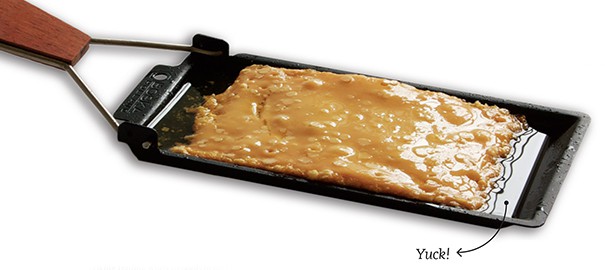
On the face of it, melting cheese would seem to be a fairly straightforward maneuver. All you need is a heat source and a good cheese, right? Yes, but there are some qualifications. I suspect I’m not alone in recalling an unexpected cooking trauma wherein pools of oil exude from a cheese, parting company with its solids, and resulting in the sum of the parts being decidedly less yummy than the whole.
What is it that makes some heated cheeses behave as described above, whereas others, such as warm raclette over potatoes or mozzarella on pizza, melt beautifully into much-loved delights? And beyond the tried and true, how do you know which other cheeses could be good melters or not?
Well, as it turns out, the chemistry behind this question is really complex. As I learned, there is also a considerable difference between soft cheeses such as Camembert that begin to run when exposed to heat, and firmer cheeses that undergo a chemical change that causes them to melt smoothly or, to use the official phrase, “flow” when heated. All of this gets into some dangerously geeky territory, so in an effort to understand the why and how, I sought guidance from researchers Carol Chen and Dana Wolle of the Wisconsin Center for Dairy Research.
First Chen explained some basics. “Cheese, in its fundamental composition, is a continuous matrix of protein strands embedded with milk fat, carbohydrate, and water,” she said. “The strength of the protein matrix determines how the cheese melts or flows when heat is applied.”
She then went on to describe several primary factors, all interrelated, that affect the strength of the structure:
-
Calcium content and cheese acidity
Calcium cross-links with protein strands (their opposite charges attract—calcium is positive, protein negative). This attraction gives strength to the protein matrix. The acidity in cheese, however, can gradually dissolve calcium, breaking these cross-links. So the more calcium that is present in the cheese, in an undissolved form, the slower and more cohesive is the melt of the cheese.
-
The age of the cheese
The protein strands in cheese form a three-dimensional structure, made up of amino acids linked together. As a cheese matures and ages, some of the proteins break apart into peptides (short amino acid strands) and individual amino acids. The resulting fragmented protein matrix is less able to contain fat during cheese melting, allowing the fat to “oil off,” or separate from the protein mass.
-
The composition of the cheese
Once again, this refers to the density of the protein matrix. Cheeses with a drier texture contain higher protein levels. Therefore, the protein matrix is denser than in moist cheeses, so the cheese melts less easily than those products with a higher moisture content. Whether the cheese remains cohesive during melting depends on the cheese’s pH/acidity and the degree of protein breakdown.
Using the examples of younger cheddar and raclette‐typically great melters‐it’s interesting to note how this reaction to heat varies as they age, progressing through different stages of maturity. When young, these types of cheeses melt more slowly and cohesively. As cheddar and raclette mature, Wolle explained, “they melt and flow more readily but still fairly cohesively.
Hot Picks
When you’re choosing a cheese for melting or cooking, Dana Wolle advises, “it’s best to stick with those between three and six months of age.” Often a mixture of cheeses will work well, too, he adds, to give the best texture and flavor. “A lot of good pizza places, for example, will use a blend of provolone, mozzarella, and Muenster so they get a nice aged flavor from the provolone but the butteriness of Muenster and the good stretch of melted mozzarella.” Regardless of whether you mix cheeses, Wolle instructs, “avoid high-fat cheeses, such as Havarti, which will oil off when heated.”
However, when they become older still‐say, after a year of aging‐an inverse effect takes place.” Now when the cheese is heated, its fragmented protein matrix is no longer able to hold all the milk fat present, and oiling off occurs. The result is that greasy pooling effect, which is even more pronounced in a higher-fat cheese; the more fat, the less protein matrix there is to trap it, which is why, for instance, a cheddar that has a fat content of 52 percent (in dry matter, which doesn’t include water content) is more likely to “oil off” than a mozzarella at 43 percent.
So what about the softer cheeses that have a high fat content? A baked Camembert, for example, melts beautifully and cohesively; in fact, it’s often runny from just the heat at room temperature. The answer lies in the fact that the protein matrix within this mold-ripened cheese has been broken down so thoroughly into tiny pieces by the action of its surface mold that the protein bits simply flow along with the fat when heated. It appears to be homogenous, without any oiling off.
If after absorbing all this information you’re feeling somewhat strained, I admit I was, too. The solution, I discovered, was to digest this miracle of chemistry with a really good cheeseburger (fresh Asiago cheese melts beautifully) and a large, cold beer.





